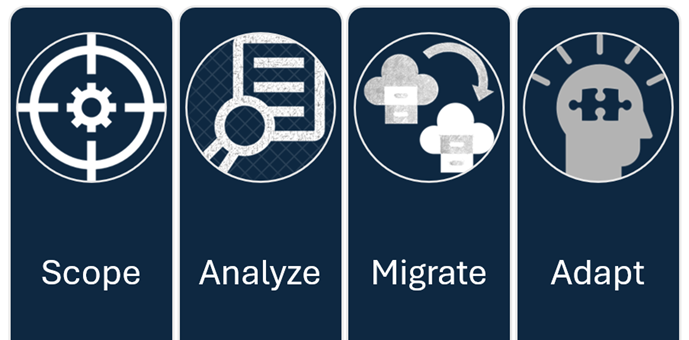 Anthony Cecchini is the President and CTO of Information Technology Partners (ITP), an ERP technology consulting company headquartered now in Virginia, with offices in Herndon. ITP offers comprehensive planning, resource allocation, implementation, upgrade, and training assistance to companies. Anthony has over 20 years of experience in SAP business process analysis and SAP systems integration. ITP is a Silver Partner with SAP, as well as an Appian, Pegasystems, and UIPath Low-code and RPA Value Added Service Partner. You can reach him at [email protected].
Anthony Cecchini is the President and CTO of Information Technology Partners (ITP), an ERP technology consulting company headquartered now in Virginia, with offices in Herndon. ITP offers comprehensive planning, resource allocation, implementation, upgrade, and training assistance to companies. Anthony has over 20 years of experience in SAP business process analysis and SAP systems integration. ITP is a Silver Partner with SAP, as well as an Appian, Pegasystems, and UIPath Low-code and RPA Value Added Service Partner. You can reach him at [email protected].
The journey from traditional ABAP custom code to a more contemporary digital landscape through SAP S/4HANA or the SAP Business Technology Platform (BTP) ABAP Environment represents a significant evolution for any organization intent on keeping pace with the rapidly changing business environment.
As SAP customer’s undertake this transformation, they must embark on a meticulous and multi-phased process. Initially, it requires a thorough delineation of the custom code elements that are essential for migration—a step that demands a deep understanding of the operational value and usage of the existing codebase. Subsequently, a comprehensive analysis is critical to determine how well the current custom code fits with the new functionalities and architectural paradigms of the SAP S/4HANA or SAP BTP ABAP Environment.
After establishing what will be migrated and ensuring its compatibility, the actual migration phase commences, which involves moving code to the new environment—a procedure that is often fraught with technical challenges and requires careful planning and execution. The final, yet equally vital, stage encompasses the adaptation of the migrated code. This adaptation is not merely a technical necessity but an opportunity to refine and optimize code to leverage the advanced capabilities of SAP’s modern platforms.
This blog will be a high level overview of the process and phases. For a more detailed explanation, please see our blog post MIGRATING CUSTOM ABAP CODE TO SAP S/4HANA.
Prior to migration, it is imperative to understand the contours of the landscape where this transformative process will unfold. For countless organizations employing SAP systems, custom code has been developed and refined over years or even decades to fit precise business needs, creating a tapestry of bespoke functionality that is tightly woven into the fabric of their daily operations. This custom code ecosystem, often sprawling into millions of lines, forms the digital backbone of an organization’s unique operational workflow, ensuring that nuanced business processes are catered to with precision.
Such a vast repository of custom-developed code, however, presents a considerable challenge when organizations want to upgrade their systems to the more advanced SAP S/4HANA, or when strategizing a migration to the cloud-native capabilities of the SAP BTP ABAP Environment. The shift to these newer platforms is not merely a technical upgrade but a substantial overhaul that necessitates a strategic and well-orchestrated migration plan. This intricacy arises from the fundamental differences in the underlying architecture of these modern systems compared to their predecessors, as well as the different operational paradigms they introduce.
Moreover, this transition is complicated by the fact that existing custom code is often deeply integrated with legacy systems and may rely on outdated technologies or database structures that are incompatible with the new SAP environments. The intricacy of these systems means that any migration effort must go beyond a simple ‘lift-and-shift’ approach. It requires an understanding of both the legacy and target environments to ensure that the custom code not only functions as expected, but also capitalizes on the performance and efficiency improvements that SAP S/4HANA and SAP BTP ABAP Environment offer.
The first phase in the migration process is the definition of the scope. This involves a thorough analysis of the existing custom code to determine which parts are essential for business operations and which can be deprecated. Surprisingly, a considerable portion of custom code in an average SAP ERP system remains unused in the production environment. Eliminating these redundant segments can substantially reduce the workload and streamline the subsequent migration phases.
Tools like ABAP Call Monitor (SCMON) and SUSG transactions are beneficial in gathering and aggregating usage data, which is a critical activity that should ideally begin a year prior to migration.
Once the scope is set, the next step is to evaluate the compatibility of the selected custom code with SAP S/4HANA or SAP BTP ABAP Environment. This is a critical process that helps identify any potential issues that might arise due to the differences between the source and target environments. The Custom Code Migration app, facilitates this analysis by checking readiness and providing a detailed report that highlights the areas that require attention.
The migration itself is a technical process wherein the Custom Code Migration app and the SAP Software Update Manager play central roles. These tools ensure that the custom code is properly transferred from the old system to the new one while allowing for exclusions as defined in the scoping phase. Additionally, for custom code that will not be part of the new system, backup strategies are recommended, which can be accomplished through various methods such as using the gCTS (Git-enabled Change and Transport System).
Post-migration, the custom code needs to be adapted to function correctly within the new system landscape. This includes making use of ABAP Development Tools in Eclipse, which offer mass-enabled Quick Fixes that can significantly expedite the adaptation process. A local ABAP Test Cockpit run is required for applying these Quick Fixes, which assesses the code for SAP S/4HANA readiness.
With the code successfully migrated, there lies a golden opportunity to further refine and optimize it. Adjustments should be made for SAP HANA optimization, with a particular focus on performance-critical SQLs. Modern development practices such as using ABAP Core Data Services (CDS), ABAP Managed Database Procedures (AMDP), and ABAP SQL should be incorporated to leverage SAP HANA’s capabilities fully. Organizations are also advised to stick to public APIs for a more resilient and cloud-ready codebase. This is also the time to consider adopting SAP Fiori UI and the ABAP RESTful Application Programming model (RAP) for a more modern user experience and architecture.
When migrating to the SAP BTP ABAP Environment, a similar approach is taken, with an emphasis on defining the scope, analyzing cloud readiness, and using the appropriate tools for migration, like abapGit for versioning and transport. This ensures that the custom code is not only lifted and shifted but also optimized for cloud operations. After the migration, the ABAP Development Tools in Eclipse will again come into play for the adaptation process, with the Quick Fixes feature of the ABAP Test Cockpit run with cloud readiness check enabled, will aid in efficient code adjustment to suit the cloud environment.
Throughout the migration journey, it’s critical for businesses to stay informed and utilize the wealth of resources and information provided by SAP, such as detailed blogs, FAQ documents, and the Custom Code Migration app’s insights. Engaging with these resources can provide a clear roadmap and support for the various stages of the migration.
Summary
The journey of migrating ABAP custom code transcends the boundaries of a mere technical challenge; it represents a strategic business initiative that is deeply intertwined with an organization’s evolution and its adaptation to new technological paradigms. Such an undertaking demands not just detailed planning and a robust understanding of the sophisticated tools and processes involved, but also a keen sense of the broader business implications.
ABAP custom code migration is a complex but ultimately rewarding process that can result in streamlined operations, enhanced capabilities, and a solid foundation for future innovation. It requires a balanced approach that values technical excellence, strategic foresight, and the human element. When executed with care and precision, it empowers businesses to not just navigate the changing tides of technology but to harness them to drive forward towards success and growth.





